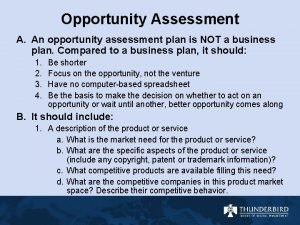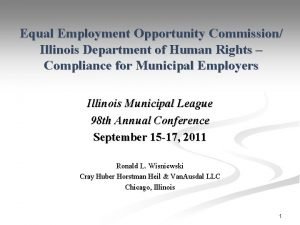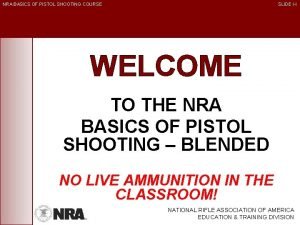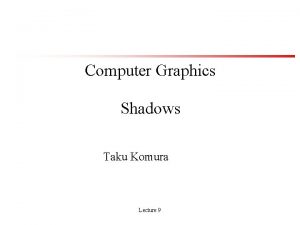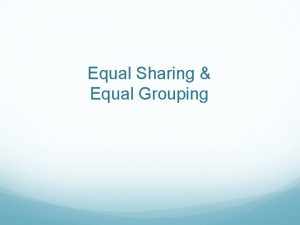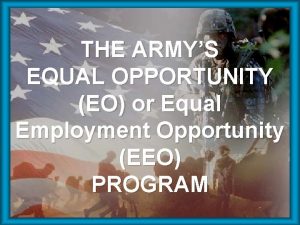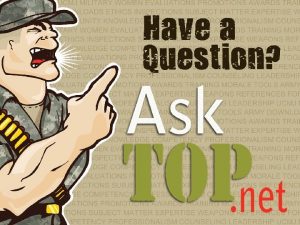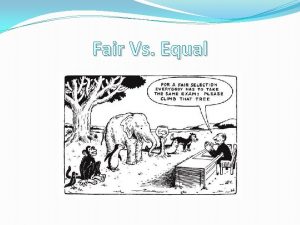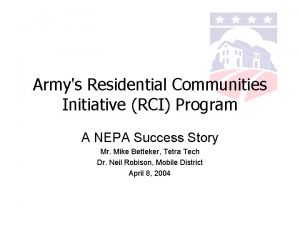THE ARMYS EQUAL OPPORTUNITY EO PROGRAM AGENDA EO


















































- Slides: 50

THE ARMY’S EQUAL OPPORTUNITY (EO) PROGRAM

AGENDA • EO References (Regulation) • EO Definition, Policy, & Principles • Key EO Personnel (EOR & EOA) • EO Areas of Concern • EO Complaint Procedures • EO Training Requirements

REFERENCES DA Pam 350 -20 AR 600 -20 (Chapter 6)

The Army’s EO Policy Ø The US Army will provide equal opportunity & fair treatment for military personnel, family members, & DA civilians without regard to: • Race • Color • Religion • Gender • or National origin Ø & provide an environment free of unlawful discrimination and offensive behavior. Ø Applies to: • On & off post. • During duty & non-duty hours. • Working, living, & recreational environments.

EO Principles Ø Commanders & leaders are responsible for EO. Ø Promote harmony, do not merely avoid disorder. Ø Support individual & cultural diversity. Ø Discipline will not be compromised. Ø Fair & equal treatment for all soldiers & civilian employees is emphasized.

EO Components Ø Leader commitment. Ø Sequential & progressive training. Ø Effective & responsive complaint system. Ø Affirmative actions plans. Ø Feedback mechanisms. Ø Equal Opportunity Advisors (EOA).

Related EO Program Issues Ø Military discipline & conduct. Ø Appropriate & professional behavior. Ø Extremist groups & gangs. Ø Army language policy. Ø Accommodating religious practices.

KEY EO Program PERSONNEL Ø UNIT LEVEL (CO-BN): • Equal Opportunity Representative (EOR). • • • Selected by the command to assist the commander. Receives two (2) weeks of formal training. Assist commander to achieve unit goals & objectives. Reinforce responsibility & authority. Reciprocal commitment between chain & soldiers. Communication channel for soldiers to voice concerns. Ø HEADQUARTERS LEVEL (BDE+): • Equal Opportunity Advisor (EOA). • Authorized for Brigade & higher levels. • Formally trained at the Defense Equal Opportunity Management Institute (DEOMI) for 16 weeks. • Dedicated position reporting directly to the commander.

EO/EEO Areas of Concern • Racism • Sexism • Prejudice • Discrimination

RACISM Any attitude or action of a person or institutional structure that subordinates a person or group because of skin color or race.

SEXISM Similar to racism. However, it is based on an attitude of superiority because of gender differences. Sexism is defined as an attitude & belief that one gender is superior to another. Sexist Behaviors: • Ignoring women or women’s issues. • Exclusionary language. • Speaking for women. • Paternalism.

PREJUDICE A negative feeling or dislike based upon faulty or inflexible generalizations. Any pre-conceived opinion or feeling which is favorable or unfavorable toward certain groups without knowing the facts. “PRE-Judged”

DISCRIMINATION Any action that unlawfully or unjustly results in unequal treatment of persons or groups based on race, color, gender, national origin, or religion. Discrimination is a violation of federal & state laws!

Leader EO Actions • Exercise On-the-Spot Correction. • Conduct Counseling - Verbal/Written. • Provide Training/Education. • Deny Promotion/Advancement. • Make decisions concerning awards, training, or schools. • Make changes in duties or responsibilities. • Initiate transfer or reassignment. • Emplace a Bar to Reenlistment. • Initiate Separation.

EO Complaint Procedures For Processing Equal Opportunity Complaints a. Individual rights. Soldiers, family members and DA civilians have the right to(1) Present a complaint to the command without fear of intimidation, reprisal, or harassment. (2) Communicate with the commander concerning their complaints. (3) Receive assistance when submitting a complaint. (4) Receive training on the Army’s Equal Opportunity complaint & appeals process. b. Individual responsibility. Individuals are responsible for: (1) Advising the command of the specifics of sexual harassment and unlawful discrimination complaints and providing the command an opportunity to take appropriate action to rectify/resolve the issue. (2) Submitting only legitimate complaints and exercising caution against unfounded or reckless charges. c. While not required, it is recommended that the individual attempt to resolve a complaint by first informing the alleged offender that the behavior must stop. d. Filing and Processing Equal Opportunity Complaints. For filing and processing of EO or sexual harassment complaints, follow the procedures as outlined in appendix E.

EO Training Requirements § Leaders /Commanders will conduct mandatory unit EO/sexual harassment training quarterly (4 x per year). § Commanders will document training on the unit’s training schedule & lead the training. § All leaders will be present & participate. § In their training documentation, commanders must include type of training; instructor; date, time & length of training; roster of attendees & issues covered in the session. § From time to time, different issues will be of local or Army-wide importance & require special emphasis & attention by unit commanders. § As a minimum, two (2) of the quarters will consist of Prevention of Sexual Harassment (POSH) training.

THE ARMY’S Sexual Harassment or Assault Response and Prevention (SHARP) Program (formerly Prevention of Sexual Harassment – POSH)

S. H. A. R. P. – What is it ? The Army’s Sexual Harassment/Assault Response and Prevention (SHARP) Program promotes a climate in which sexual assault, sexual harassment, or sexually offensive language or gestures are not tolerated, while providing sensitive care and confidential reporting for victims of sexual assault and accountability for offenders.

AGENDA • DA Definition & Policy of/on Sexual Harassment. • Categories of Sexual Harassment. • Two (2) Types of Sexual Harassment. • The effects on an individual, unit, & mission. • Leader responsibilities. • POSH Training. • Complaint Procedures. • Sexual Assault.

REFERENCES Chapter 7 Prevention Of Sexual Harassment (POSH) 7– 1. Overview • The prevention of sexual harassment is a commander’s responsibility. AR 600 -20 (Chapter 7) • The EOA plays a pivotal role by assisting the commander with policy awareness, training, command climate assessments, complaints processing & overall advisory assistance concerning the prevention of sexual harassment.

DA Policy • The policy of the Army is that sexual harassment is unacceptable conduct & will not be tolerated. • • • Army leadership at all levels will be committed to creating & maintaining an environment conducive to maximum productivity & respect for human dignity. Sexual harassment destroys teamwork & negatively affects combat readiness. The Army bases its success on mission accomplishment. Successful mission accomplishment can be achieved only in an environment free of sexual harassment for all personnel. • The prevention of sexual harassment is the responsibility of every soldier & DA civilian. Leaders set the standard for soldiers & DA civilians to follow.

DA Policy Based upon race, religion, color, sex, national origin, age, disability Leaders have a duty; a workplace free from harassment; not tolerated. Defined by laws & regulations. Report incidents. Leader responsibilities.

DEFINITION Sexual harassment is a form of gender discrimination that involves unwelcomed sexual advances, requests for sexual favors, & other verbal or physical conduct of a sexual nature. “Unwelcomed” is determined by the recipient !

When/How does it occur? • Submission to or rejection of such conduct is made either explicitly or implicitly a term or condition of a person’s job, pay, or career. • Submission to or rejection of such conduct by a person is used as a basis for career or employment decisions affecting that person. • Such conduct interferes with an individual’s performance or creates an intimidating, hostile, or offensive environment.

Harassment Behaviors • Any person in a supervisory position who: (a) Uses or condones (allows) explicit or implicit sexual behavior to control, influence, or affect the career, pay, or job of another soldier or civilian employee is engaging in sexual harassment. (b) Makes deliberate or repeated unwelcomed verbal comments, gestures, or physical contact of a sexual nature is engaging in sexual harassment.

Harassment Principles • Is not limited to the work place. • Can occur anywhere. • Violates acceptable standards. • Interferes with mission accomplishment. • Will not be engaged in by soldiers or Army civilians.

CATEGORIES of SEXUAL Harassment • Verbal • Nonverbal • Physical

VERBAL - Sexual Harassment • Profanity- obscene or degrading terms for men or woman & inappropriate use of terms of endearment. • Obscene jokes, cat calls, or cadence with sexual overtones (including email & attachments). • Spreading rumors about an individuals’ sex life. • Sexually oriented remarks about a person’s clothing or body. • Persistent requests for dates.

NON-VERBAL - Sexual Harassment • Gestures made with intentional sexual overtones. • Staring, leering, blowing kisses, licking lips. • Leaving sexually suggestive magazines, notes, cartoons, mugs, or pictures (calendars/pin-ups). ** Overlooking, ignoring, or failing to take action on illegal activities or reported sexual harassment.

PHYSICAL - Sexual Harassment • Unsolicited or unwanted touching of any part of clothing or body (neck/back massages). • Cornering or blocking. • Stalking or following.

“Reasonable Person” Standard ASK YOURSELF THE QUESTION: • How would a reasonable person under similar circumstances react or be affected by such behavior? Men & women can watch the same behavior, but have very different perspectives about what they saw & what they are feeling.

TYPES of Sexual Harassment • Quid pro quo. • Hostile environment: - Offensive comments. - Unwanted comments. - Unsolicited comments.

QUID PRO QUO • Latin term meaning: “this for that. ” • Placing conditions on person’s job/terms of employment in return for sexual favors. • Making promises of career advancement, promotions, or other benefits in exchange for sexual favors.

HOSTILE Environment • Offensive, Unwanted, & Unsolicited comments & behaviors of a sexual nature (sexual jokes; email or spoken). • Most prevalent form of sexual harassment in the Army. “I was only joking” is not an excuse

EFFECTS of Sexual Harassment • Effects on INDIVIDUALS: - anger. - reduction in performance. - avoidance. - increased absentee rate. - self-blame.

EFFECTS of Sexual Harassment • Effects on UNIT: - loss of unit cohesion. - low morale. - undermines readiness. • Effects on MISSION: - detracts from mission accomplishment.

TECHNIQUES of Dealing w/ Sexual Harassment a. Direct approach. Confront the harasser & tell him/her that the behavior is not appreciated, not welcomed & that it must stop. Stay focused on the behavior & its impact. Use common courtesy. Write down thoughts before approaching the individual involved. b. Indirect approach. Send a letter to the harasser stating the facts, personal feelings about the inappropriate behavior & expected resolution. c. Third party. Request assistance from another person. Ask someone else to talk to the harasser, to accompany the victim, or to intervene on behalf of the victim to resolve the conflict. d. Chain of Command. Report the behavior to immediate supervisor or others in chain of command & ask for assistance in resolving the situation. e. File a formal complaint. Details for filing an informal or formal complaint are included in Appendix E of AR 600 -20.

LEADER Responsibilities • • Examine your own behavior. Provide a healthy environment. Control social interaction (“parties”). Take corrective actions. Establish & enforce standards. Read & understand policies. Be knowledgeable. Educate & inform all soldiers.

POSH Training § The elimination of sexual harassment within a unit begins with a policy of aggressive & progressive training to identify & prevent inappropriate behavior. § Conduct progressive, interactive small group sexual harassment training twice (2 x) each year. It must also be documented in training records. Everyone must attend, to include EOA personnel. § Soldiers must understand what sexual harassment is, how to recognize it, how to prevent it, how to report it & the consequences of engaging in sexual harassment.

COMPLAINT Procedures Complaints: Filing and processing of sexual harassment complaints follow the same procedures as outlined in Appendix E of AR 600 -20 for EO complaints. Charges of sexual misconduct (assault) are to be processed through legal / law enforcement channels, not equal opportunity (EO) channels.

TYPES of COMPLAINTS • Formal: • Submitted in writing. • Requires chain of command intervention. • Reported to higher headquarters. • Filed within 60 calendar days from date of alleged offense. • Specific time lines for processing. • Informal process will not resolve complaint. • Attempt at informal resolution failed. • Complainant desires an official record. • Complaint is against a member of the chain of command. • Informal: • Does not desire chain of command intervention. • Assistance from other unit members. • Confidentiality is possible (but not guaranteed). • Assistance not required in writing. • Good chance for success. • Complaint is not severe.

Alternative Agencies • A higher echelon commander. • Command Equal Opportunity Advisor (EOA). • Chaplain (CH). • Staff Judge Advocate (SJA). • Provost Marshal (PM). • Inspector General (IG). • Community Referral/Relocation Services Office. • Medical Agency Personnel.

Intimidation, Harassment, & Reprisal ARMY Policy prohibits the following: • Prohibits any action by supervisors to discourage filing EO complaints or seeking assistance with EO grievances. • Prohibits any disciplinary action against the complainant. • Does not preclude action for fraudulent complaints or false statements.

Administrative Disciplinary Actions • Bar to reenlistment. • Letter of admonishment or reprimand. • Relief for cause. • Rehabilitative transfer. • Additional training. • Required counseling. • Denial of certain privileges.

Sexual Assault Definition: Sexual assault is a crime defined as crime intentional sexual contact, characterized by use of force, physical threat or abuse of authority or when the victim does not or cannot consent. Sexual assault includes: • Rape • Nonconsensual sodomy. • Indecent assault (unwanted, inappropriate sexual contact or fondling • Attempts to commit these acts. • Sexual assault can occur without regard to gender or spousal relationship (married) or age of victim. • Other sex-related offenses in violation of UCMJ could include indecent acts with another and adultery.

Why so important ? Why is this important to the Army? • Sexual Assault is a crime that has no place in the Army. • It is contrary to Army Values and degrades mission readiness by devastating a unit’s ability to work effectively as a team. • Preventing sexual assault is about leadership and discipline. • Soldiers deserve committed leaders who are dedicated to preventing sexual assault and harassment, as well as an environment free from sexual assault, harassment and sexual innuendo and comments.

REFERENCES SEXUAL ASSAULT is a CRIMINAL offense, punishable by federal, state, & military (UCMJ) laws! It must reported immediately! AR 600 -20 (Chapter 8) It will not be tolerated in our military! Training is MANDATORY!

The Army's Sexual Harassment/Assault Response & Prevention (SHARP) program exists so the Army can prevent sexual prevent harassment and sexual assaults before they occur. Our goal is to eliminate sexual harassment and sexual assaults by creating a climate that respects the dignity of every member of the Army Family.

SUMMARY • Communicate DA’s policy on Equal Opportunity (EO) & Sexual Harassment/Assault to your Soldiers/unit. • Know, understand, & recognize the forms & categories of sexual harassment/assault. • Know & understand the effects of sexual harassment/assault on an individual, unit, & mission. • Know & understand the leader’s responsibilities in preventing sexual harassment/assault. • Know & understand the strategies for combating sexual harassment/assault.

THE ARMY’S EO & SHARP PROGRAMS
 An opportunity assessment plan is
An opportunity assessment plan is Equal opportunity fund
Equal opportunity fund Equal employment opportunity illinois
Equal employment opportunity illinois Equal opportunity and the law chapter 2
Equal opportunity and the law chapter 2 Equal height equal light
Equal height equal light Equal height equal light
Equal height equal light Equal grouping and equal sharing
Equal grouping and equal sharing Opposite angle
Opposite angle Equal area vs equal angle stereonet
Equal area vs equal angle stereonet Agenda sistemica y agenda institucional
Agenda sistemica y agenda institucional Hình ảnh bộ gõ cơ thể búng tay
Hình ảnh bộ gõ cơ thể búng tay Frameset trong html5
Frameset trong html5 Bổ thể
Bổ thể Tỉ lệ cơ thể trẻ em
Tỉ lệ cơ thể trẻ em Chó sói
Chó sói Glasgow thang điểm
Glasgow thang điểm Chúa yêu trần thế
Chúa yêu trần thế Môn thể thao bắt đầu bằng từ đua
Môn thể thao bắt đầu bằng từ đua Thế nào là hệ số cao nhất
Thế nào là hệ số cao nhất Các châu lục và đại dương trên thế giới
Các châu lục và đại dương trên thế giới Công thức tính thế năng
Công thức tính thế năng Trời xanh đây là của chúng ta thể thơ
Trời xanh đây là của chúng ta thể thơ Cách giải mật thư tọa độ
Cách giải mật thư tọa độ 101012 bằng
101012 bằng Phản ứng thế ankan
Phản ứng thế ankan Các châu lục và đại dương trên thế giới
Các châu lục và đại dương trên thế giới Thơ thất ngôn tứ tuyệt đường luật
Thơ thất ngôn tứ tuyệt đường luật Quá trình desamine hóa có thể tạo ra
Quá trình desamine hóa có thể tạo ra Một số thể thơ truyền thống
Một số thể thơ truyền thống Cái miệng nó xinh thế chỉ nói điều hay thôi
Cái miệng nó xinh thế chỉ nói điều hay thôi Vẽ hình chiếu vuông góc của vật thể sau
Vẽ hình chiếu vuông góc của vật thể sau Biện pháp chống mỏi cơ
Biện pháp chống mỏi cơ đặc điểm cơ thể của người tối cổ
đặc điểm cơ thể của người tối cổ Thế nào là giọng cùng tên?
Thế nào là giọng cùng tên? Vẽ hình chiếu đứng bằng cạnh của vật thể
Vẽ hình chiếu đứng bằng cạnh của vật thể Fecboak
Fecboak Thẻ vin
Thẻ vin đại từ thay thế
đại từ thay thế điện thế nghỉ
điện thế nghỉ Tư thế ngồi viết
Tư thế ngồi viết Diễn thế sinh thái là
Diễn thế sinh thái là Dot
Dot Các số nguyên tố là gì
Các số nguyên tố là gì Tư thế ngồi viết
Tư thế ngồi viết Lời thề hippocrates
Lời thề hippocrates Thiếu nhi thế giới liên hoan
Thiếu nhi thế giới liên hoan ưu thế lai là gì
ưu thế lai là gì Hổ sinh sản vào mùa nào
Hổ sinh sản vào mùa nào Khi nào hổ mẹ dạy hổ con săn mồi
Khi nào hổ mẹ dạy hổ con săn mồi Hệ hô hấp
Hệ hô hấp Từ ngữ thể hiện lòng nhân hậu
Từ ngữ thể hiện lòng nhân hậu
